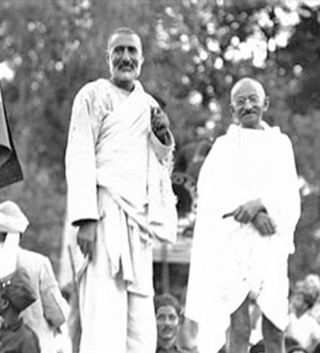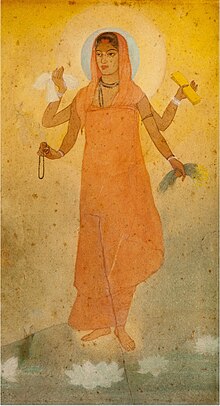
The Indian independence movement was a series of historic events with the ultimate aim of ending British rule in India also known as British Raj. It lasted until 1947.

The dhoti, also known as veshti, mardani, dhotar, jaiñboh & panchey, is a type of garment, fastened in between the legs in a manner that it resembles trousers in shape, it may be fitted loosely but other tighter fittings are worn as well. It is most popular in India and Nepal. The dhoti is a lower garment forming part of ethnic wear for men in the Indian subcontinent. The dhoti is fashioned out of a rectangular piece of unstitched cloth, usually around 4.5 metres (15 ft) long, wrapped around the waist and the legs and knotted, either in the front or the back.

Bipin Chandra Pal was an Indian nationalist, writer, orator, social reformer and freedom fighter. He was one third of the "Lal Bal Pal" triumvirate. He was one of the main architects of the Swadeshi movement. He is known as the Father of Revolutionary Thoughts in India. He also opposed the partition of Bengal by the British colonial government.

The national flag of India, colloquially called Tiraṅgā, is a horizontal rectangular tricolour flag, the colours being of India saffron, white and India green; with the Ashoka Chakra, a 24-spoke wheel, in navy blue at its centre. It was adopted in its present form during a meeting of the Constituent Assembly held on 22 July 1947, and it became the official flag of the Union of India on 15 August 1947. The flag was subsequently retained as that of the Republic of India. In India, the term "tricolour" almost always refers to the Indian national flag.
Wardha is a city and a municipal council in Wardha district in the Indian state of Maharashtra. The administrative headquarter of Wardha district is situated here. Wardha gets its name from the Wardha River which flows on the northern, western and southern boundaries of the district. Founded in 1866, the town is now an important centre for cotton trade. Wardha was an important part of the Gandhian era.

Khadi, derived from khaddar, is a hand-spun and woven natural fibre cloth promoted by Mahatma Gandhi as swadeshi (self-sufficiency) for the freedom struggle of the Indian subcontinent, and the term is used throughout India, Pakistan and Bangladesh. The first piece of the hand-woven cloth was manufactured in the Sabarmati Ashram during 1917–18. The coarseness of the cloth led Gandhi to call it khadi. The cloth is made from cotton, but it may also include silk or wool, which are all spun into yarn on a charkha. It is a versatile fabric that remains cool in summer and warm in winter. To improve its appearance, khadi is sometimes starched to give it a stiffer feel. It is widely accepted in various fashion circles.

The Khadi and Village Industries Commission (KVIC) is a statutory body formed in April 1957 by the Government of India, under the Act of Parliament, 'Khadi and Village Industries Commission Act of 1956'. It is an apex organisation under the Ministry of Micro, Small and Medium Enterprises, with regard to khadi and village industries within India, which seeks to - "plan, promote, facilitate, organise and assist in the establishment and development of khadi and village industries in the rural areas in coordination with other agencies engaged in rural development wherever necessary.".

Gandhism is a body of ideas that describes the inspiration, vision, and the life work of Mohandas K. Gandhi. It is particularly associated with his contributions to the idea of nonviolent resistance, sometimes also called civil resistance.

The first Partition of Bengal (1905) was a territorial reorganization of the Bengal Presidency implemented by the authorities of the British Raj. The reorganization separated the largely Muslim eastern areas from the largely Hindu western areas. Announced on 16 July 1905 by Lord Curzon, then Viceroy of India, and implemented West Bengal for Hindus and East Bengal for Muslims, it was undone a mere six years later. The nationalists saw the partition as a challenge to Indian nationalism and as a deliberate attempt to divide the Bengal Presidency on religious grounds, with a Muslim majority in the east and a Hindu majority in the west. The Hindus of West Bengal complained that the division would make them a minority in a province that would incorporate the province of Bihar and Orissa. Hindus were outraged at what they saw as a "divide and rule" policy, even though Curzon stressed it would produce administrative efficiency. The partition animated the Muslims to form their own national organization along communal lines. To appease Bengali sentiment, Bengal was reunited by King George V in 1911, in response to the Swadeshi movement's riots in protest against the policy.

The Gandhi cap is a white sidecap, pointed in front and back and having a wide band. It is made out of khadi. It takes its name after the Indian leader Mahatma Gandhi, who created it and first popularised its use during the Indian independence movement.
The Karnataka Khadi Gramodyoga Samyukta Sangha (KKGSS) is a manufacturing federation located in Garag village near Dharwad City and also its headquarters in Bengeri of Hubli City in Dharwad district, Karnataka, India. It is one of the five units in India that are authorised by the Bureau of Indian Standards (BIS) to manufacture and supply the Indian flag.
Weaving and cloth trading communities of Western India particularly of Gujarat are called Vankar/Wankar/Vaniya. The four major woven fabrics produced by these communities are cotton, silk, khadi and linen. Today majority of these community members are not engaged in their ancestral weaving occupation still some population of these community contribute themselves in traditional handloom weaving of famous Patola of Patan, Kachchh shawl of Bhujodi in Kutch, Gharchola and Crotchet of Jamnagar, Zari of Surat, Mashroo of Patan and Mandvi in Kutch, Bandhani of Jamnagar, Anjar and Bhuj, Motif, Leheria, Dhamakda and Ajrak, Nagri sari, Tangaliya Shawl, Dhurrie, Kediyu, Heer Bharat, Abhala, Phento and art of Gudri. Vankar is described as a caste as well as a community.
Ambujammal Desikachari née Srinivasa Iyengar (1899-1983) was an Indian independence activist and women's rights activist. A Gandhian, she participated in the Civil Disobedience Movement and served as vice-president of the Tamil Nadu Congress Committee. Ambujammal was awarded the Padma Shri in 1964.

MGIRI Mahatma Gandhi Institute for Rural Industrialization (MGIRI), earlier named as National Institute for Rural Industrilization (NIRI), is an autonomous institution located in Wardha, Maharashtra, India whose purpose is to accelerate the process of rural industrialization by providing science and technology support. It is inspired by the Gandhian vision of sustainable and self reliant village economy.
Fanindranath Gooptu mostly known as F.N. Gooptu was an Indian industrialist. He led manufacturing of writing instruments such as fountain pens with an indigenous process, pencils, nips of fountain pens, ink etc. His own company F. N. Gooptu & Co. was situated at the Beliaghata region of Kolkata, India.
Gangadharrao Balkrishna Deshpande also known as Lion of Karnataka, Khadi Bhageeratha of Karnataka, was an Indian activist who was the leader of the Indian independence movement against British colonial rule from Belgaum. He was the right-hand man of both Lokamanya Tilak and Mahatma Gandhi in succession. Deshpande considered Lokamanya Tilak as his Guru. Deshpande served as Chairman of Karnataka branch of All-India Spinners' Association, and the All India Village Industries Association for some years. Deshpande was largely responsible for the installation of Premier of Bombay, B. G. Kher.
Ashalata Sen was an activist, poet, social worker, and a leading figure in the Indian independence movement.

The Prince of Wales riots occurred in Bombay, British India, between 19 and 22 November 1921 during the visit of Edward, Prince of Wales. The visit came during the non-cooperation movement protests for Indian self-rule, led by Mahatma Gandhi and the Indian National Congress. Gandhi had allied the mainly Hindu Congress with the Muslim Khilafat Movement, who were concerned about the possibility that the British might depose the Ottoman Caliph. Gandhi called for his supporters to boycott the prince's visit and carry out a general strike (hartal).
Upendra Maharathi was an Indian artist who worked in various mediums including painting, sculpture, illustration, architecture, graphic design, and textile design. He was born in the village of Narendrapur in Odisha and received his art education at the Government College of Art & Craft in Kolkata under Mukul Dey and Percy Brown. After completing his studies, he settled in Bihar. His more than 900 works have been preserved by the National Gallery of Modern Art, Delhi.

Shantipur Handloom Industry, also known Shantipur Handloom Cluster, is a handloom weaving industry in Nadia district of West Bengal. It is one of the foremost handloom centers of India. This handloom industry is world famous for the production of cotton Sari (saree). The two main centers of this industrial zone are Shantipur and Phulia. Shantipur has an old reputation for cotton sarees, known as Shantipuri sarees, and Phulia is well known for Tangail-Jamdani sarees.













